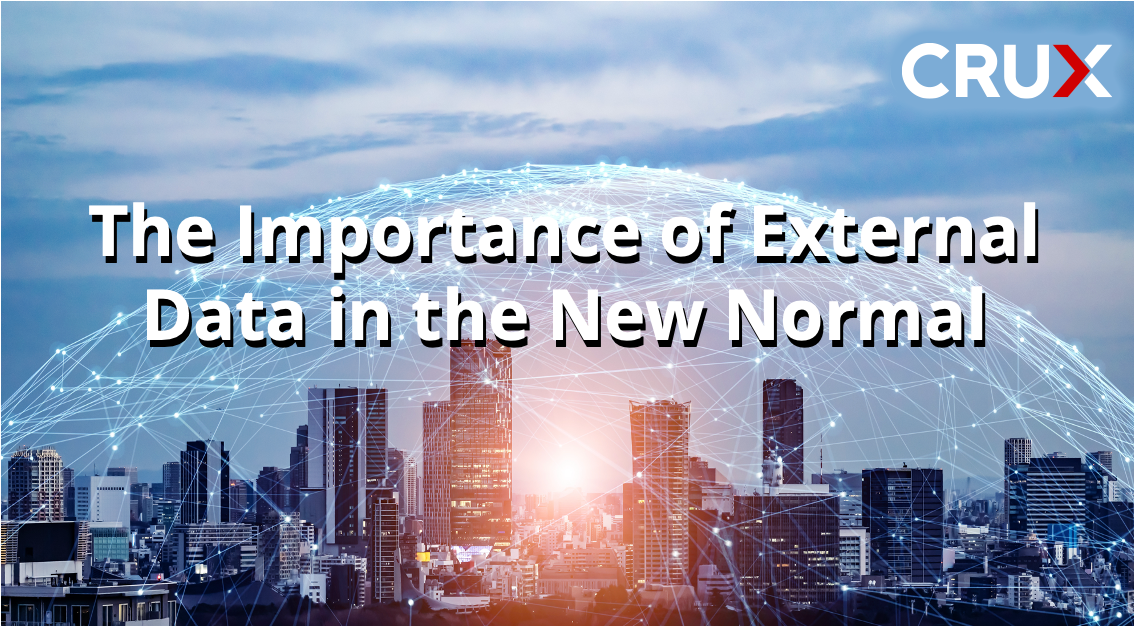Crux appoints industry veteran, naggi asmar as CTO
I recently had the opportunity to interview Naggi Asmar, Crux’s new Chief Technology Officer, and I was excited to learn more about his journey, his...

Consumption of external data is growing everywhere. However, the fragmented and diverse data supply is riddled with unique challenges to getting to data integration at scale.
The topic is addressed as a 2-part series.
The onset of the global pandemic in 2019 demonstrated the global economic environment's connectivity to the ever-changing and complicated mirage of external data, both captured and hidden for busy business executives to make critical decisions. Supply chain issues facing large and small companies demonstrate the challenges facing global marketers impacted by events worldwide. Outsourced and customized external data collection streamlines the data, providing accuracy and timeliness and enhancing agile decision-making while simultaneously managing the use of resources to maximize results.
With external data comes the ability to make the right decisions when facing global trends. Emerging sustainable technologies are a good example. If Tesla is a leading indicator, companies promoting a green vision while delivering a capable product may have multiple times higher valuations than the biggest competitors combined. For example, besides the annual 10-K statements that show how an organization financially performs, there is a similar ESG (Environmental, Social, and Governance) report. The accuracy of this ESG report may sway institutional investors and customers alike to adopt new relationships based on their social conscience.
In recent decades, leading organizations have followed data tech giants such as Google, Apple, and Amazon who adapted quickly by diversifying the types and increasing the amount of data they process. Witnessed by the rise in AI/ML investments that can scan through TBs of log file data to analyze trends across the complete lifecycle as the relationship with the customer evolves. The customer experience and knowledge of where a customer is in the process improve operations and create an evolving set of digital and physical products that increase loyalty and revenue.
Over the past ten years, the focus on internal data sources has broken down organizational barriers to understanding previously disconnected or ignored data. And with a shift to open-source and cloud computing, which made connecting to data affordable, many companies are ready to truly understand the full context of their business in the global marketplace so that they can predict issues and prepare rather than react. As the value of the underlying data is worth more than any individual company, or even country, the rewards for those that get it right are more significant than ever.
Historically, financial institutions have imported data from external sources such as Bloomberg or Factset, creating a valuable data trail. Yet this is now common across every industry sector and magnified significantly to the consumer when thinking about the retail sector. Retailers share sales information with their suppliers, such as CPG (Consumer Product Goods) companies, to allow them to tailor the marketing, promotions, and product launches. And the examples that could be listed here are endless. Yet, the challenge, no matter the industry is to recognize that if you can harness the value from external data provides, you will achieve a significant competitive advantage.
In this virtual environment, data management is critical to making intelligent decisions that pay off in the boardroom and across every business layer. In the past, leaders made decisions with less than 40% of the available data. Still, with new data integration platforms and managed service providers, transparency across varying data sources and formats remove the blind spots that once existed. The companies that are innovators in their space are supplementing their data with external/third-party datasets to make better strategic decisions that have a more significant impact.
Data-sharing and consumption between external parties offer additional operational improvements and the ability to increase revenue by addressing a bigger market. As innovators rush to answer complex issues, such as understanding the entire supply chain, or supplier/outlet dependency, they realize there is an almost unlimited set of possible datasets that help drive business decisions. External data mining is both an art and a science as these organizations seek to find the right formula for their company to solve the most pressing problems in today’s connected virtual world of data technology.
Crux offers managed data to supplement your data engineering needs for integrating external data from many sources. We have pre-built pipelines to hundreds of data sources and over 24,000 datasets to accelerate access to the most used datasets and build specific data pipelines to deliver data in tailored frequencies to the location of their choice (often to a cloud, but we support a range of delivery methods). For some of our larger enterprise customers, we manage thousands of datasets across many suppliers to remove the complexity and burden of managing from their teams. Clients look to us to handle the details from onboarding, prep and enhancement, delivery, monitoring, and maintenance of this data. If you are interested in learning more about how we might be able to help your organization, contact us
This is part 1 in a 2-part series - click over to read part 2.
To learn more about Crux and its data engineering and operations offering, contact us.

I recently had the opportunity to interview Naggi Asmar, Crux’s new Chief Technology Officer, and I was excited to learn more about his journey, his...

As 2024 draws to a close, the Crux Data team has been reflecting on the key trends shaping 2025. #1 out of them all? Operational Alpha.

Not long ago, we observed here in our blog that the critical insights that drive business value come from data that is both (1) fast and (2) reliable.